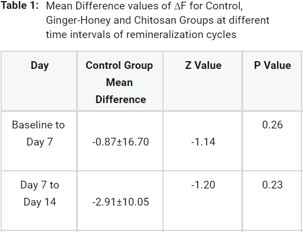Abstract
Early detection and treatment of white spot lesions (WSL) is pivotal in caries control. Several commercially available products are available for WSL reversal. However, the majority of them are either synthetically derived or are not a hundred percent efficient. Thus there is an ever constant need to find newer, more efficacious products for the same. One of the parameters to quantify de and remineralization is by Quantitative Light Induced Fluorescence (QLF). Thus this study aims to evaluate and compare the remineralizing potential of Zingiber officinale Roscoe (Ginger rhizome), Apis Mellifera (Manuka Honey) mixture and chitosan on artificial demineralized human enamel using Quantitative Light Induced Fluorescence. 45 human enamel samples were randomly divided into a control and two test groups. An Area of Interest (AOI) measuring 4x4 mm on the buccal surface of each tooth was formed and all the samples were subjected to demineralization process for a period of 96 hours. Remineralization regime was then carried out with twice daily application of respective interventional agents for a period of 21 days. QLF readings were recorded at the end of demineralization (Baseline), Day 7, Day 14 and Day 21 and fluorescence images were analysed using QLF InpektorTM propriety software. The remineralization action of chitosan was found to be the highest with a statistically significant reduction (p<0.001) seen at the end of 7th, 14th and 21st day. Ginger- honey mixture also showed reduction in fluorescence levels but only after the 14th day. The current study showcases the dramatic ability of chitosan to almost completely reverse artificially formed WSL at each subsequent week. Ginger honey on the other hand showed a significant remineralization between 2nd and 3rd week which may be attributed to a possible slower mechanism of action.
Full text article
Authors

This work is licensed under a Creative Commons Attribution-NonCommercial-NoDerivatives 4.0 International License.

